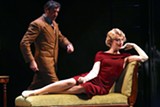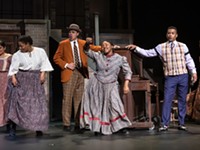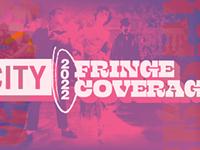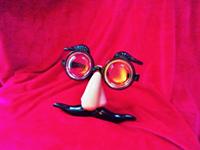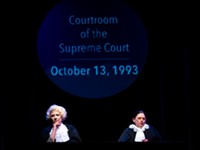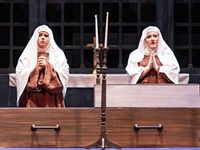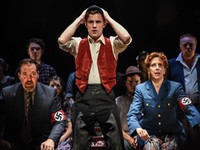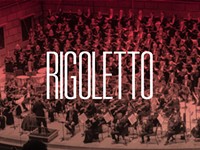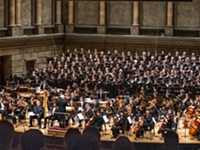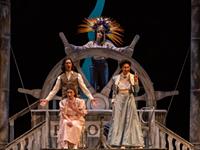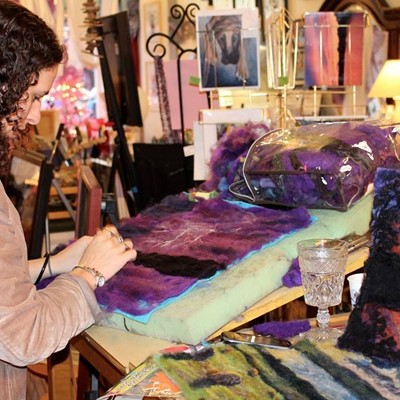[
{
"name": "500x250 Ad",
"insertPoint": "5",
"component": "15667920",
"parentWrapperClass": "",
"requiredCountToDisplay": "1"
}
]
When you walk into the house for Geva's current production of "The 39 Steps," the first thing you see is a good, old-fashioned proscenium framing a good, old-fashioned red curtain. That's a pretty retro visual for a modern theater production, but it turns out to be a perfect visual introduction for this one. If you are a theatergoer of a certain age, that richly lit red curtain is an immediate clue that something magical and unique is about to happen, the kind of experience you can only get from real actors on a real stage. And while "The 39 Steps" is uproariously funny, make no mistake: it is definitely theatrical magic.
"The 39 Steps" started out back in 1915 as a suspense novel by John Buchan, but it is best known now as a 1935 Alfred Hitchcock movie starring Robert Donat and Madeleine Carroll. Patrick Barlow's recent stage adaptation (which has a long history of its own, including a long run on Broadway) mostly draws on the Hitchcock film, which includes early examples of many of the Hitchcockian tropes we know from his famous American movies like "North by Northwest," "Rear Window," and "Vertigo." Elements like "the wrong man accused and on the run, trains, cool blondes, smooth villains, music, and the MacGuffin," to quote from Jean Gordon Ryon's interesting program essay.
About the MacGuffin: as Hitchcock fans know, this was the master's term for the device that gets the plot going, the thing everybody wants and the good guy needs to retrieve from the bad guy. To Hitchcock, the MacGuffin wasn't really important in itself, but it was the hook on which the all the fun stuff hangs. You take note of it at the beginning of the show and can pretty much forget about it once the plot starts churning. In "The 39 Steps," the MacGuffin is a top-secret formula for something-or-other that makes aircraft engines run silently. You don't find this out until the last minutes of the show, and after two hours of adventure you don't really care. The sense of play's the thing.
Well, "The 39 Steps" does have a plot of sorts: a suave Brit named Richard Hannay (John Gregorio), single and at loose ends in London, goes to a show at the Palladium where he encounters an alluring, mysterious German blonde named Annabella (Monica West). She spends the night in his flat, but Hannay finds her the next morning with a knife in her back, and finds himself on the run to a mysterious location in Scotland, along with a mysterious squadron of spies called "The 39 Steps." Frantically attempting to clear his name and find out what all of this means, Hannay ends up back at the Palladium, where the "39 Steps" are identified, the secret revealed, and the villain dispatched just in time.
I won't give any more away, except to mention that it involves Nazis, corset salesmen, Scottish people with hilariously impenetrable accents, a rogue herd of sheep, and a number of very funny references to other Hitchcock films (besides the three mentioned earlier, "The Birds" and "Psycho" get called into service).
The really remarkable part of "The 39 Steps" is not the story, but the way the story is told. Barlow's adaptation — fast-talking, satirical, and inventive — finds a very plausible 21st century theatrical counterpart to Hitchcock's mingling of suspense and drollery. Sean Daniels' staging is equally nimble, grabbing ideas from Brecht, Broadway musicals, Kabuki theatre, Monty Python, and more, throwing in a few Rochester references for good measure.
All of the roles in the play — 150 of them, we're told, and I completely believe it — are played by four actors, and Geva's foursome puts on one amazing show. John Gregorio's Richard Hannay is perfect: athletic, sharp-witted, a bit goofy, and — being British — unfailingly suave (he tears through London and Scotland wearing a single double-breasted suit, and it never betrays a wrinkle). Monica West deliciously embodies the three women in the plot. Her Annabella looks like an Art Deco dream, but her hysterical take on a German accent may remind Britcom fans of Helga on "'Allo! 'Allo!" As the nubile Highland siren Margaret, she seems to be a character from a Scottish Tennessee Williams; as Pamela, the woman who turns Hannay in and ends up helping him, West perfectly embodies the prim-but-sexy vibe of any number of 1930's movie heroines.
That leaves about 146 other roles in the play, and they are all taken by two performers billed only as Clown No. 1 (Aaron Munoz) and Clown No. 2 (Joel Van Liew). These two actors are remarkably agile, switching costumes, accents, genders, and occasionally species on a dime and apparently without breaking a sweat. Munoz is stocky and Van Liew tall and thin — they look like Laurel and Hardy, and some of their business is worthy of that great comedy duo. (A bit involving the two of them trying to escape through a "rear window" is worth the price of a ticket in itself.)
"The 39 Steps" may nominally be about spies and secret formulas, but it's really about Theater with a capital T: four actors, a director, and designers, and the amount of hilarious theatrical mayhem they can all churn up together. The cast of Geva's "39 Steps" succeeds wonderfully — and I must add that they are helped immensely by Geva's stagehands, who deservedly join the cast in their final bow.
